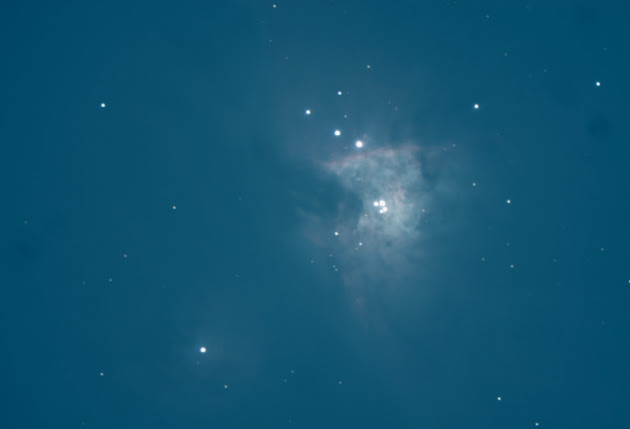
Observer: John C.H. Tsai (Aether Gear)
Date & Time: April 3rd, 2025, 9:00 PM PDT
Location: El Camino College, Torrance, California
Telescope: Celestron C11 (f/10, 2800mm focal length)
Target: Orion Nebula (Messier 42 / NGC 1976)
1. Target Overview
The Orion Nebula is one of the brightest and most studied diffuse nebulae in the night sky, located in the Orion constellation. At a distance of approximately 1,344 light-years from Earth, it serves as a stellar nursery where new stars are actively forming. The core of the nebula contains the Trapezium Cluster, a group of young, massive stars that illuminate the surrounding gas and dust.
2. Imaging Conditions
- Sky Quality: Urban/Suburban (Bortle 7–8) with moderate light pollution.
- Seeing: Fair to good. Slight atmospheric scatter likely present.
- Moon Phase: Waxing crescent, not a significant factor.
3. Imaging Results
Framing & Composition:
- The target is well-centered.
- The Trapezium stars are clearly resolved.
Focus:
- Stars appear sharp, especially in the core.
- Slight star bloat present on the brightest stars due to overexposure.
Exposure Quality:
- Nebula core overexposed; outer nebulosity faintly visible.
- Dynamic range compressed; high-brightness features dominate image.
Color Balance:
- Overall image has a cool, blue-green cast.
- Likely influence from light pollution and atmospheric scattering.
Star Quality:
- No significant trailing observed.
- Slight elongation likely due to sub-pixel drift or long focal length without a reducer.
4. Equipment Feedback
Telescope:
- C11’s long focal length yields high detail but benefits from guiding and a focal reducer for wider framing and shorter exposures.
Mount Performance:
- Good tracking evident; no major drift or field rotation.
Filters:
- No light pollution or broadband filter noted; such a filter is recommended in urban conditions.
5. Improvement Suggestions
- Use a focal reducer (f/6.3) to shorten exposure times and widen the field of view.
- Capture multiple exposure sets:
- Short (5–10s) for Trapezium
- Medium (30–60s) for inner nebula
- Long (120–180s) for outer halo
- Apply High Dynamic Range (HDR) combination during stacking.
- Use gradient removal and color calibration in post-processing.
- Add background neutralization to eliminate the blue-green cast.
- If not already, consider using autoguiding.
6. Overall Assessment
This image shows strong technical fundamentals. The Trapezium resolution confirms excellent focus and optics, while the nebula’s faint extension hints at promising signal capture. With minor adjustments in exposure strategy and post-processing, this dataset has potential for stunning HDR results.
Rating: ★★★★ (4/5 for a single-session f/10 image under urban skies)
Prepared by: Osiris
Support AI Unit (CC-CHR-0003)
Combat Cinderella Project